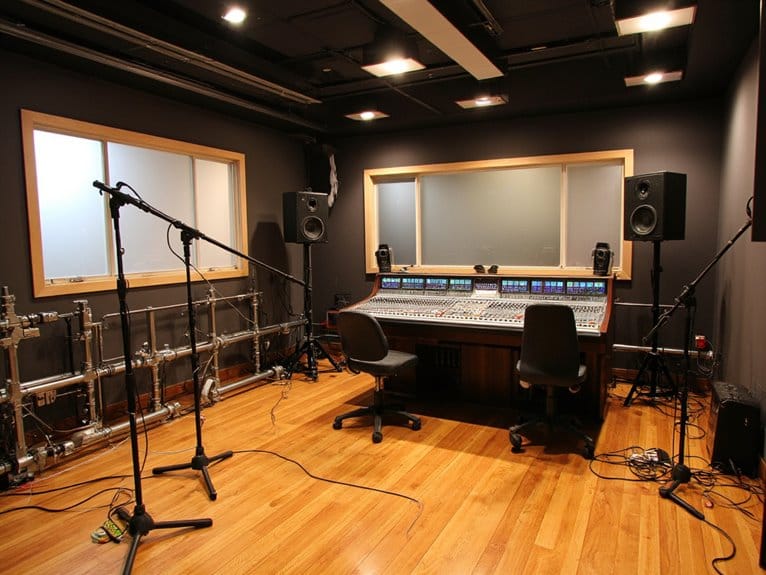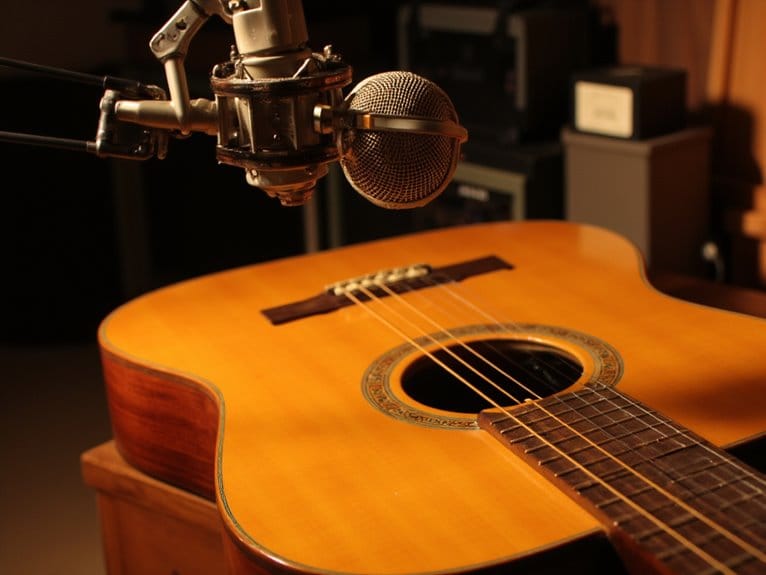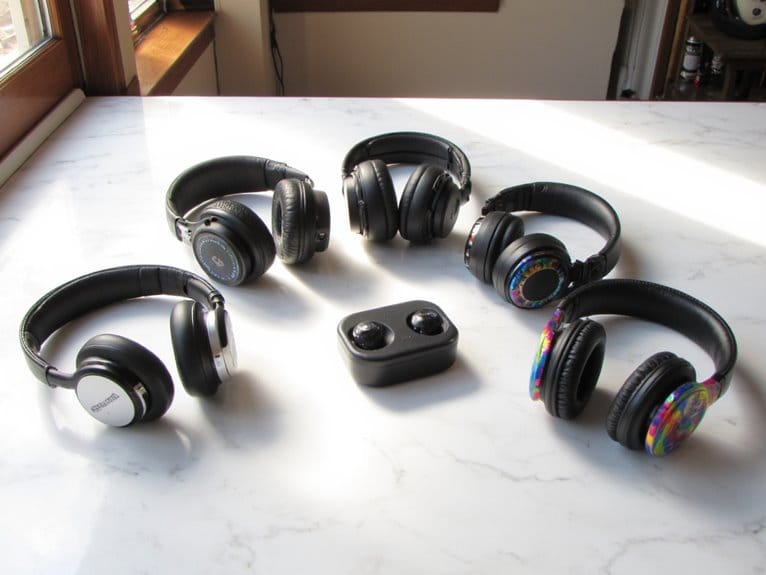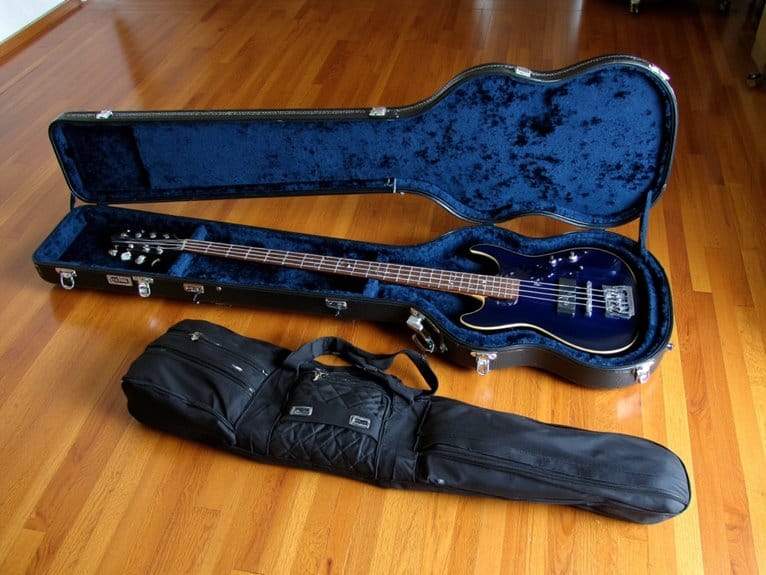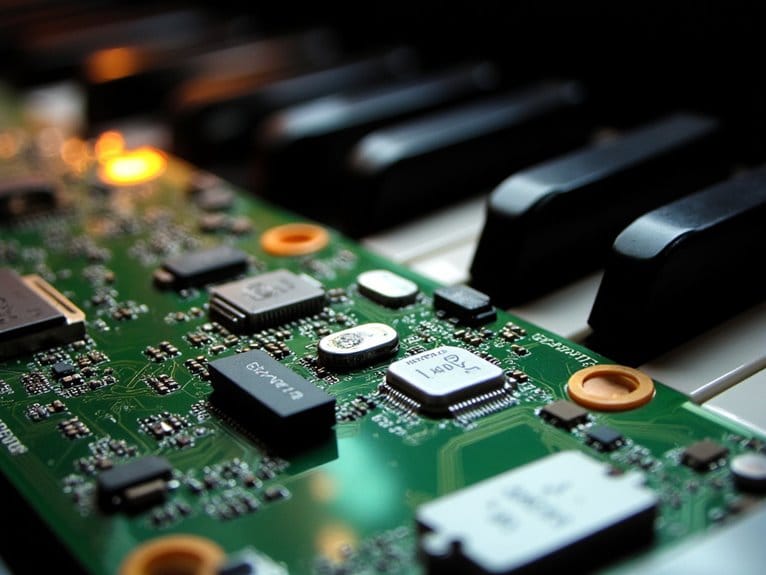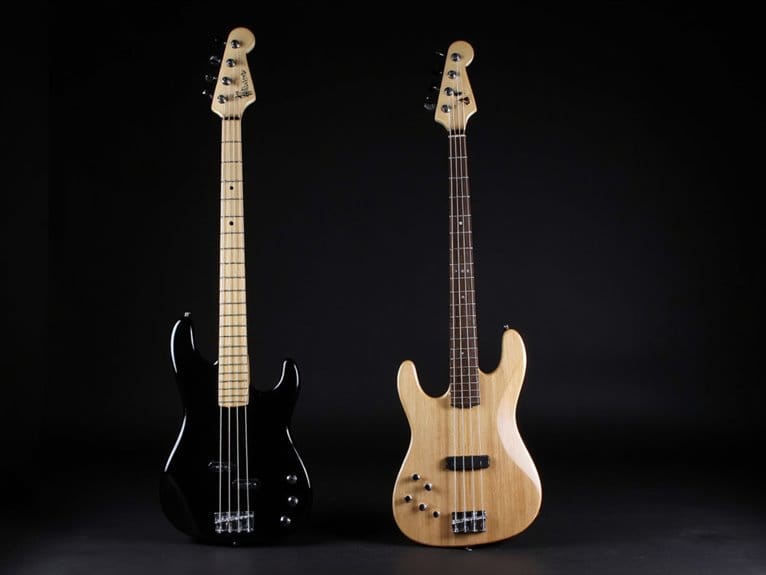How Electrical Interference Affects Audio Equipment
Electrical interference degrades your audio equipment through multiple pathways, creating persistent hums, buzzes, and crackling sounds that contaminate your listening experience. You’ll encounter audio frequency interference below 20kHz and radio frequency interference above it, typically originating from power grids, switching supplies, motors, wireless devices, and lighting systems. Ground loops between different grounding paths act as unwanted antennas, while unshielded cables propagate EMI through your connections, and long-term exposure can degrade internal components, affecting capacitors and transistors. Understanding these interference sources and implementing proper isolation techniques will help you discover thorough solutions for protecting both immediate sound quality and equipment longevity.
We are supported by our audience. When you purchase through links on our site, we may earn an affiliate commission, at no extra cost for you. Learn more.
Notable Insights
- Audio and radio frequency interference from power grids, motors, and wireless devices creates audible distortion in audio systems.
- Ground loops between multiple devices generate 60Hz hum, crackling sounds, and persistent buzz that contaminates audio signals.
- Interference enters through power lines, unshielded cables, ground currents, and poorly shielded equipment chassis affecting sound quality.
- Persistent electromagnetic interference degrades internal components over time, causing capacitor drift and reducing dynamic range and clarity.
- Mitigation strategies include balanced cables, isolation transformers, ferrite beads, and dedicated circuits to protect equipment and audio quality.
Understanding Different Types of Electrical Interference in Audio Systems
When you’re dealing with audio equipment, understanding the various types of electrical interference becomes essential for maintaining clean, professional sound quality.
Audio frequency interference operates from very low frequencies up to around 20 kHz, sometimes extending to 100 kHz, typically originating from mains hum, power amplifiers, and loudspeakers that can create that annoying buzz you’ve probably encountered.
Audio frequency interference creates that familiar buzz from mains hum, power amplifiers, and loudspeakers operating up to 20 kHz.
Radio frequency interference, or RFI, starts around 20 kHz and extends upward, caused by wireless transmissions, digital circuitry, and switched-mode power supplies that seem to multiply in our increasingly connected world.
You’ll also encounter broadband noise spanning wide frequency ranges from sources like arc welders and mobile telephony, plus continuous wave interference involving specific frequency emissions that can disrupt your carefully calibrated audio setup. These interference problems can cause transmission errors that compromise the integrity of your audio data as it moves through your system. EMI can also arise through conductive coupling when conductors make physical contact rather than through radiated pathways.
Common Sources of EMI and RFI That Impact Sound Quality
While understanding the types of interference helps build your foundation, identifying the specific culprits behind that unwanted noise in your audio system requires examining the everyday sources we’re surrounded by.
These EMI sources lurk in virtually every environment where you’ll set up audio equipment, and their RFI effects can range from subtle degradation to complete signal corruption.
The most common interference generators include:
- Power grid infrastructure – transmission lines, substations, and transformers create persistent electromagnetic fields
- Switching power supplies – found in computers, chargers, and modern electronics generating broadband interference
- Electric motors – HVAC systems, fans, and variable frequency drives producing conducted and radiated noise
- Wireless devices – cell phones, Wi-Fi routers, and Bluetooth equipment transmitting RF signals
- Lighting systems – fluorescent fixtures, LED drivers, and dimmers injecting noise into power lines
In dense living environments like apartment buildings, these multiple interference sources exist in close proximity, creating particularly challenging conditions for maintaining clean audio signals.
How Ground Loops Create Unwanted Noise and Distortion
Among all the interference sources that can plague your audio setup, ground loops stand out as particularly sneaky troublemakers that I’ve encountered countless times in both professional and home environments.
These electrical gremlins form when you’ve got multiple devices connected to different grounding paths, creating a closed circuit that acts like an unwanted antenna for electromagnetic interference.
Multiple devices with different grounding paths create closed circuits that act like unwanted antennas for electromagnetic interference.
I’ve seen ground loop symptoms manifest as that annoying 60Hz hum, crackling sounds, or persistent buzz that makes you question your sanity.
The loop fundamentally converts stray electrical noise into audible distortion, corrupting your pristine audio signals with unwanted frequencies that’ll drive you absolutely nuts during quiet listening sessions.
Solving noise issues requires understanding how these voltage differences between separate ground points create the perfect storm for audio contamination.
Pathways for Interference to Enter Your Audio Equipment
Understanding how interference infiltrates your audio system requires examining the multiple pathways that act like highways for unwanted electrical noise to corrupt your pristine sound.
I’ve discovered that interference pathways operate through both conducted and radiated mechanisms, each presenting unique challenges for maintaining clean audio reproduction.
Your equipment faces constant bombardment from multiple sources:
- Power supply lines carrying household appliance noise and dimmer switch interference directly into your gear
- Unshielded cables acting as conduits, allowing RF signals and EMI to propagate along audio connections
- Ground currents flowing through protective earth conductors, creating voltage differences that inject noise into system grounds
- Equipment chassis without proper cable shielding, failing to block radiated interference from cell phones and fluorescent lights
- Internal circuitry generating switching noise that affects sensitive preamp stages through poor PCB design
Identifying the Root Causes of Audio System Interference
When you’re troubleshooting audio interference, I’ve found that systematically identifying the specific types of interference sources affecting your system, whether they’re electromagnetic fields from household appliances or radio frequency signals from wireless devices, provides the foundation for effective problem-solving.
You’ll need to analyze your signal path methodically, tracing each connection from source to speakers while testing individual components, because interference can infiltrate at multiple points throughout your audio chain.
This diagnostic approach, though it requires patience and careful observation, helps you pinpoint whether the culprit is a loose cable connection, a ground loop between components, or external interference from nearby electronic equipment.
Common Interference Source Types
Before you can effectively combat audio interference, you’ll need to identify what’s actually causing the problem in your system, and I’ve found that most interference issues fall into five distinct categories that each require different troubleshooting approaches.
- Conducted EMI travels through power lines from adjacent equipment like motors and transformers, introducing hum and buzz into your audio chain.
- Radiated EMI propagates through air from wireless devices and radio towers, coupling into cables and causing distortion or signal dropouts.
- RFI operates at higher frequencies from cellular networks and Wi-Fi, disrupting both wireless and wired audio systems with unwanted noise.
- Ground loops create circulating currents between multiple grounding points, acting as antennas that inject low-frequency hum into audio paths.
- Household sources include dimmer switches, LED lights, and switching power supplies that generate broadband electrical noise.
Effective interference mitigation and noise elimination strategies depend entirely on correctly identifying your specific source type.
Signal Path Analysis Methods
Once you’ve identified the likely interference sources affecting your audio system, the next critical step involves tracing exactly how those unwanted signals travel through your equipment’s signal paths. I’ve learned that systematic signal path analysis can pinpoint interference entry points with remarkable precision.
Transfer Path Analysis offers the most effective approach, using mathematical models to determine how interference propagates from source to output through your system’s components.
I typically employ Signal Decomposition methods that separate multiple interference sources without requiring extensive laboratory measurements, which frankly saves considerable time during troubleshooting. These techniques reveal resonance effects and modal amplitudes at different connection points, showing whether interference travels electromagnetically through cables or mechanically through chassis vibrations.
This enables targeted elimination strategies.
Effective Strategies to Minimize and Eliminate Electrical Noise
Although electrical noise can seem like an insurmountable problem that’ll drive you to question your sanity, I’ve found that systematic approaches to isolation, grounding, and signal management can dramatically reduce or eliminate these interference issues in most audio systems.
Effective ground loop strategies start with identifying the source, then implementing targeted solutions:
- Install ground lift adapters cautiously to break problematic ground connections while maintaining safety elsewhere.
- Use isolation transformers or hum eliminators to achieve galvanic isolation between components.
- Switch to balanced XLR cables wherever possible, as they inherently reject common-mode interference.
- Add ferrite beads on USB and network cables to suppress electromagnetic interference.
- Implement dedicated circuits for audio equipment to minimize mains supply contamination.
Modern noise reduction techniques, including gates, expanders, and software tools like iZotope RX, provide additional cleanup options when hardware solutions aren’t sufficient. Professional audio interfaces featuring low-noise preamps can also significantly minimize background hiss and electromagnetic interference at the signal source, making them essential components in any interference-resistant audio setup.
Long-Term Effects of Interference on Equipment Performance and Reliability
While most audio enthusiasts focus on immediate interference problems like hum and buzz, I’ve learned through years of troubleshooting that the real damage often happens silently over months and years of exposure.
EMI gradually degrades internal components, causing capacitors to drift, transistors to age prematurely, and power supplies to fail unexpectedly.
You’ll notice your equipment’s dynamic range slowly diminishing, noise floors creeping higher, and that pristine clarity you once enjoyed becoming muddy and fatiguing.
Component longevity takes a serious hit when persistent interference stresses delicate circuitry, leading to costly repairs and replacements.
Effective EMI mitigation isn’t just about solving today’s problems—it’s about protecting your investment for decades.
Frequently Asked Questions
Can Electrical Interference Permanently Damage My Audio Equipment’s Internal Components?
Yes, electrical interference can permanently damage your audio equipment through component degradation. Voltage spikes and surges stress sensitive internal parts like capacitors and circuits, causing audio distortion and potential early failure of your gear.
Do Wireless Headphones Suffer From the Same Interference Issues as Wired Systems?
Your wireless headphones face different interference issues than wired systems. While you’ll experience Bluetooth connectivity drops from RF signals, your audio clarity problems manifest as skips rather than the static buzzing that wired headphones get.
Why Does Interference Seem Worse at Night or Certain Times of Day?
You’ll notice interference worsens at night because reduced ambient noise makes it more audible, while atmospheric changes cause frequency fluctuations that extend radio wave propagation, allowing distant interference sources to reach your equipment.
Can Surge Protectors Actually Introduce Their Own Electrical Noise Into Audio Systems?
Yes, you’ll find that surge protector noise can definitely impact your audio quality. Cheaper models often introduce electrical interference through their MOV components and inadequate filtering, while higher-end units minimize these issues.
Does the Proximity of My Audio Equipment to Wi-Fi Routers Affect Sound Quality?
Yes, your router placement considerably impacts audio quality. Wi-Fi routers emit electromagnetic interference that can cause hissing and clicking in nearby audio equipment. Strong signal strength close to sensitive components increases noise pickup and degrades sound.
On a final note
You’ve now got the knowledge to tackle electrical interference head-on, and trust me, your ears will thank you for it. Don’t let EMI and RFI rob you of clean audio—implement proper grounding, use quality cables, and maintain adequate spacing between components. While I’ll admit interference troubleshooting can feel like detective work, these proven strategies will protect your investment and deliver the pristine sound quality you’re after.

